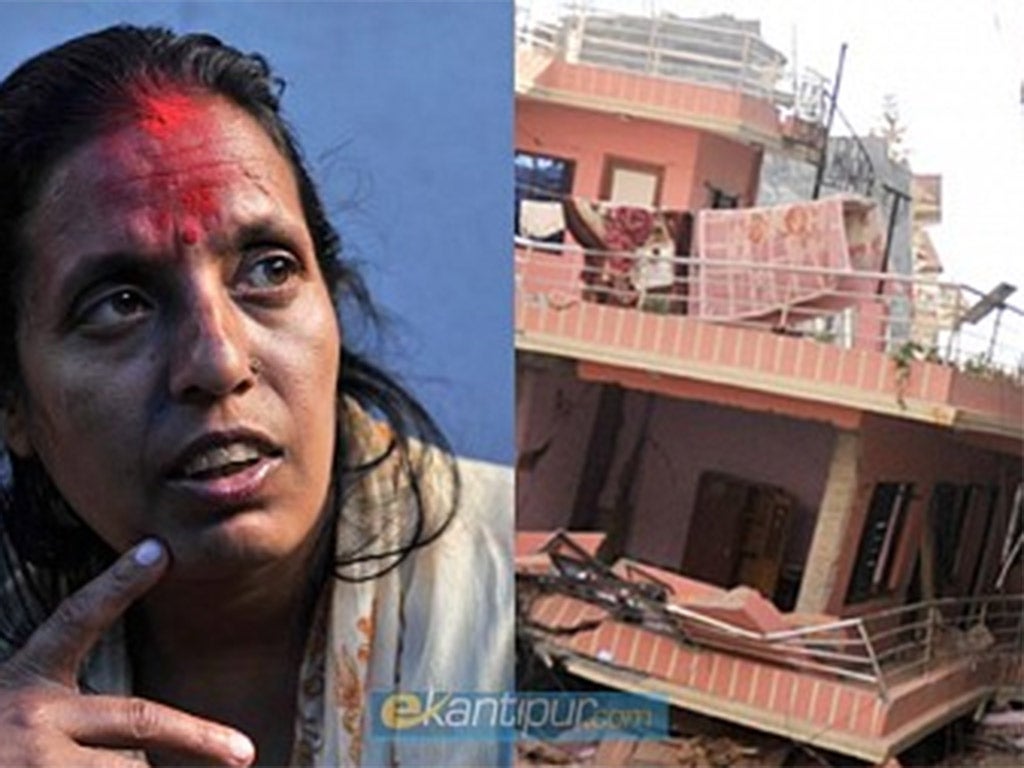Your support helps us to tell the story
From reproductive rights to climate change to Big Tech, The Independent is on the ground when the story is developing. Whether it's investigating the financials of Elon Musk's pro-Trump PAC or producing our latest documentary, 'The A Word', which shines a light on the American women fighting for reproductive rights, we know how important it is to parse out the facts from the messaging.
At such a critical moment in US history, we need reporters on the ground. Your donation allows us to keep sending journalists to speak to both sides of the story.
The Independent is trusted by Americans across the entire political spectrum. And unlike many other quality news outlets, we choose not to lock Americans out of our reporting and analysis with paywalls. We believe quality journalism should be available to everyone, paid for by those who can afford it.
Your support makes all the difference.Sunita Sitaula’s husband and two sons escaped. They ran from their pink five-storey building as the earthquake struck. She was less lucky. The building collapsed, she was buried in her kitchen.
For almost two days she heard nothing but the sounds of a city in ruins. Then, after 33 hours peering through a tiny trap of light, she heard a voice, speaking in Hindi: an Indian rescue worker had arrived.
Recalling the earthquake, she said: “I was washing dishes inside the kitchen. All of a sudden, the entire house stared trembling. My husband and children managed to escape but I could not. I was trapped inside the house. I was helpless.” Her body was covered by a vast chunk of the kitchen floor, she said. “I was helpless and hopeless, there was no chance of moving, I prayed to God,” she added. She said she spent much of the first day, Saturday, in tears.
At some point, she said, a voice could be heard outside. “Someone is alive here!” Sunita remembers a man saying. “Let’s leave here. Go to other side.” Her hopes dashed, she yesterday told The Independent at Bashandura Academy – a Kathmandu school where her husband and children had been taking shelter while she lay buried – that she had was certain she would die.
“Save the lives of the people who are alive,” Sunita remembers shouting through the chink of light. “Forget about those who died.” She added: “I did not see any ray of hope. Probably, those hours were one of the longest moments of my life. There was lots of fear and anxiety.
“I remembered my husband and child, no one came to rescue and those who gave a little hope to me did not come back,” she said. “All of a sudden on Monday afternoon, I heard a voice.” Sunita was rescued, and taken to one of the makeshift hospitals that have sprung up across Nepal’s devastated capital. Unlike many thousands of others, she was unhurt. “I was really surprised,” she said of her lack of serious injury. “My health was fine even after being trapped for 33 hours.”
She said she was buried under wood, not cement and bricks. “If it had been cement, I would have been dead,” she said. Her story of survival amid the death of the earthquake and subsequent aftershocks is not unique. The Nepalese Army was yesterday said to have rescued a man trapped for 62 hours. A joint team of Chinese and Turkish workers reportedly rescued a man, who was identified as “John KC” in Balaju, north-west of Kathmandu. He had been trapped on what was the second floor of a house.
Meanwhile, Chandra Wani Gajamu, 35, was also rescued alive from Balaju area after 53 hours yesterday morning. She suffered minor injuries. One man in central Nepal sent a text to his family while trapped. It was not delivered on time. Later, when relatives saw that he was trapped through his message, they requested help. On Monday, a team retrieved his body.

Join our commenting forum
Join thought-provoking conversations, follow other Independent readers and see their replies
Comments